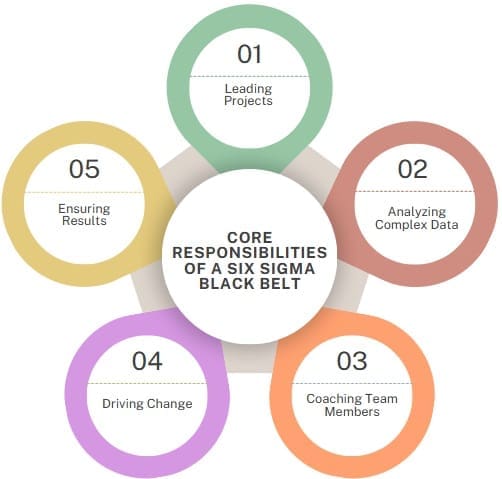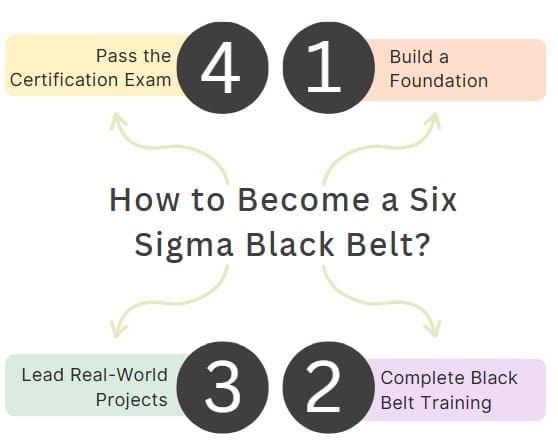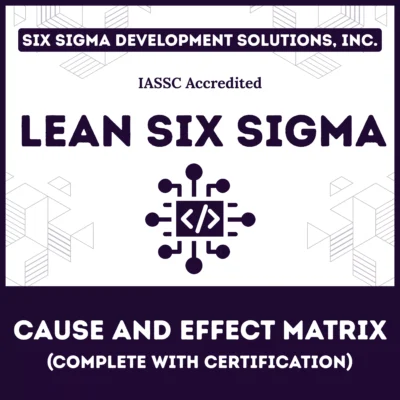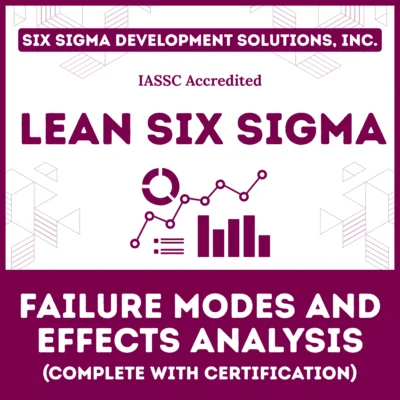The concept of the Six Sigma Black Belt emerged as part of the broader Six Sigma methodology developed in the 1980s by Motorola. At the time, Motorola was facing intense competition from Japanese manufacturers, who had gained a reputation for producing high-quality products with minimal defects.
To improve its own quality standards, Motorola introduced Six Sigma—a data-driven approach aimed at reducing variation and improving process consistency. As the methodology gained traction, companies realized the need for skilled professionals who could lead complex quality improvement projects. This led to the introduction of the belt-based hierarchy, inspired by martial arts, to represent different levels of expertise.
The Black Belt designation was created to identify professionals with advanced knowledge of Six Sigma tools and the leadership skills necessary to manage cross-functional improvement teams. Black Belts became the core drivers of Six Sigma projects, capable of delivering measurable results in cost savings, quality enhancement, and process efficiency.
In the 1990s, General Electric (GE), under the leadership of CEO Jack Welch, helped popularize Six Sigma globally. GE invested heavily in training thousands of Black Belts and Master Black Belts, making Six Sigma a strategic priority across all business units.
Today, Six Sigma Black Belts are recognized worldwide as leaders in process improvement, helping companies across industries—from manufacturing and healthcare to finance and IT—achieve operational excellence.
Table of contents
What Is Six Sigma?
Before diving into the Black Belt role, it’s helpful to understand the Six Sigma concept.
Six Sigma is a business improvement strategy that uses data and statistical analysis to reduce process variation and eliminate defects. Its goal is to reach near-perfect quality—just 3.4 defects per million opportunities.
The Six Sigma approach typically follows the DMAIC framework:
- Define – Identify the problem or process needing improvement
- Measure – Collect data to understand current performance
- Analyze – Identify the root causes of defects
- Improve – Implement solutions to resolve those root causes
- Control – Put systems in place to sustain the improvements
Six Sigma professionals earn different “belt” levels, similar to martial arts. The ranks include:
- White Belt
- Yellow Belt
- Green Belt
- Black Belt
- Master Black Belt
Let’s now explore what makes the Black Belt level so important.
Public, Onsite, Virtual, and Online Six Sigma Certification Training!
- We are accredited by the IASSC.
- Live Public Training at 52 Sites.
- Live Virtual Training.
- Onsite Training (at your organization).
- Interactive Online (self-paced) training,
What Is a Six Sigma Black Belt?
A Six Sigma Black Belt is a process improvement expert trained to lead complex projects that aim to eliminate waste, reduce errors, and increase efficiency. They have deep expertise in statistics, project management, and leadership.
Unlike Green Belts, who typically support projects part-time, Black Belts are full-time professionals who take ownership of large-scale improvements. They guide teams, solve critical business problems, and deliver measurable results.
In Short:
A Six Sigma Black Belt is a certified professional who leads data-driven process improvement projects using Six Sigma principles, tools, and methodologies.
Core Responsibilities of a Six Sigma Black Belt

Black Belts hold a high level of accountability and often report directly to department heads or upper management. Their key responsibilities include:
1. Leading Projects
They manage Six Sigma projects from start to finish. This includes defining objectives, organizing teams, and keeping projects aligned with strategic goals.
2. Analyzing Complex Data
Using tools like regression analysis, hypothesis testing, and design of experiments (DOE), Black Belts turn raw data into insights and actions.
3. Coaching Team Members
Black Belts mentor Green Belts and others within the organization, building a culture of continuous improvement.
4. Driving Change
They don’t just solve problems—they create lasting changes. That involves working with leadership, addressing resistance, and monitoring progress long-term.
5. Ensuring Results
They are accountable for project outcomes and must demonstrate how changes lead to better performance, lower costs, or higher customer satisfaction.
Also See: IASSC Certified Lean Six Sigma Black Belt Mock Exam
Skills Required to Be a Six Sigma Black Belt
The role demands both technical know-how and soft skills. Below are some essential competencies:
- Strong analytical thinking
- Knowledge of statistics and data analysis
- Leadership and team management
- Project management skills
- Clear and persuasive communication
- Business acumen
- Conflict resolution and change management
Some roles may also require familiarity with software like Minitab, JMP, or advanced Excel.
How to Become a Six Sigma Black Belt?

Achieving Black Belt certification involves training, experience, and passing an exam. Here’s how to do it:
1. Build a Foundation
It’s recommended to start by earning a Green Belt certification. This ensures you have a strong understanding of Six Sigma principles before moving to advanced levels.
2. Complete Black Belt Training
Enroll in an accredited Black Belt course. Topics usually include:
- Advanced statistical analysis
- Root cause analysis
- Process mapping
- Change management
- Risk assessment (FMEA)
- Project leadership
Courses can be taken online, in-person, or through company programs.
3. Lead Real-World Projects
Most certification bodies require candidates to complete one or two real-life projects that demonstrate the application of Six Sigma tools and methods.
4. Pass the Certification Exam
You’ll need to pass a comprehensive exam that tests your knowledge of Six Sigma tools, DMAIC methodology, and project leadership.
Reputable Certifying Bodies:
- ASQ (American Society for Quality)
- IASSC (International Association for Six Sigma Certification)
- CSSC (Council for Six Sigma Certification)
Also See: IASSC Lean Six Sigma Black Belt Examination Voucher
Benefits of Six Sigma Black Belt Certification
The return on investment for a Six Sigma Black Belt certification is high—both for professionals and organizations.
For Professionals:
- Career advancement: Opens doors to roles like Process Improvement Manager, Quality Manager, or Operations Director.
- Increased salary: Black Belts earn significantly more than non-certified peers.
- Leadership roles: Gain respect and authority in business improvement circles.
- Transferable skills: Six Sigma is used globally and across industries.
For Organizations:
- Operational efficiency: Reduce waste, costs, and errors.
- Better decision-making: Use data, not guesswork.
- Higher customer satisfaction: Deliver consistent, quality experiences.
- Stronger culture of accountability: Teams become empowered problem-solvers.
Six Sigma Black Belt Salary Expectations
According to recent industry surveys and job market data, Six Sigma Black Belts are well-compensated.
| Experience Level | Average Salary (U.S.) |
| Entry-Level | $80,000 – $95,000 |
| Mid-Career | $100,000 – $120,000 |
| Senior-Level | $120,000 – $150,000+ |
Salaries vary depending on your location, industry, and project success. Some consultants and contractors can earn even more per project.
Industries That Hire Six Sigma Black Belts
Though Six Sigma began in manufacturing, it’s now used in nearly every sector:
- Healthcare – Improve patient care and reduce medical errors
- Finance – Streamline operations, reduce risk
- Retail – Optimize inventory and supply chains
- Technology – Increase system reliability and customer support
- Logistics – Cut costs and improve delivery times
- Telecommunications – Improve network uptime and customer experience
Six Sigma Black Belt vs. Green Belt: What’s the Difference?
| Feature | Green Belt | Black Belt |
| Time Commitment | Part-time | Full-time or lead role |
| Project Ownership | Support role | Leads projects |
| Level of Training | Intermediate | Advanced |
| Statistical Tools | Basic to moderate | Advanced |
| Leadership | Minimal | Key leadership role |
Also See: Lean Six Sigma Black Belt Project Management Kit
Common Tools Used by Six Sigma Black Belts

1. Pareto Charts
A Pareto Chart is a bar graph that highlights the most significant factors in a dataset. It’s based on the Pareto Principle (80/20 rule), showing that roughly 80% of problems come from 20% of causes.
2. Fishbone Diagrams (Cause-and-Effect Diagrams)
Also called Ishikawa diagrams, these help visualize potential causes of a problem. The diagram looks like a fish skeleton, with the “head” representing the problem and the “bones” showing categories of possible causes.
3. Control Charts
Control Charts are graphs that plot data over time and help monitor process stability. By showing upper and lower control limits, Black Belts can quickly see if a process is behaving normally or if there’s variation that needs investigation.
4. Failure Mode and Effects Analysis (FMEA)
FMEA is a structured method for identifying all possible ways a process or product can fail and prioritizing them based on severity, occurrence, and detection.
5. SIPOC Diagrams
SIPOC stands for Suppliers, Inputs, Process, Outputs, and Customers. This high-level process map helps Black Belts understand and define the boundaries of a process, identify stakeholders, and clarify inputs and outputs before detailed analysis.
A Value Stream Map is a flowchart that visualizes every step in a process from start to finish, highlighting value-added and non-value-added activities.
7. Statistical Software (e.g., Minitab, JMP, Excel)
Black Belts often use specialized statistical software to analyze complex data sets, perform hypothesis testing, regression analysis, and design experiments. Programs like Minitab and JMP simplify these tasks, while Excel provides flexible data handling for many analyses.
Final Words
Six Sigma Black Belts rely on a diverse set of proven tools to identify problems, analyze data, and implement lasting improvements. From visual aids like Pareto Charts and Fishbone Diagrams to advanced risk assessment techniques like FMEA and process mapping tools like SIPOC and Value Stream Mapping, these resources empower Black Belts to make informed, data-driven decisions.
Coupled with powerful statistical software, these tools help uncover root causes, monitor processes, and ensure sustained success.
Mastering these tools is essential for any Black Belt aiming to lead high-impact projects and drive meaningful change within their organization. By leveraging the right tools, Black Belts can transform complex challenges into opportunities for efficiency, quality, and growth.
Also Read: Lean Six Sigma Black Belt Projects
FAQ – Frequently Asked Questions
What is a Six Sigma Black Belt?
A Six Sigma Black Belt is a certified professional who leads business improvement projects using data-driven methods and statistical analysis to eliminate defects and improve quality.
How do I become a Six Sigma Black Belt?
You must complete training, pass a certification exam, and lead real-world improvement projects. Prior Green Belt certification is often recommended.
Is a Six Sigma Black Belt certification worth it?
Yes. It can boost your salary, job opportunities, and ability to lead projects in any industry.
How long does it take to become certified?
Depending on your experience, it typically takes 2–6 months including training, project work, and exam preparation.
What industries use Six Sigma Black Belts?
Industries include manufacturing, healthcare, finance, logistics, IT, and telecommunications.

About Six Sigma Development Solutions, Inc.
Six Sigma Development Solutions, Inc. offers onsite, public, and virtual Lean Six Sigma certification training. We are an Accredited Training Organization by the IASSC (International Association of Six Sigma Certification). We offer Lean Six Sigma Green Belt, Black Belt, and Yellow Belt, as well as LEAN certifications.
Book a Call and Let us know how we can help meet your training needs.




















